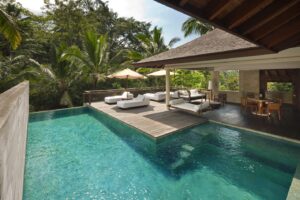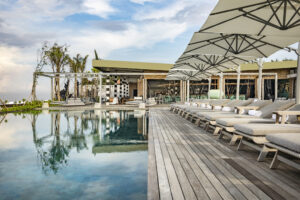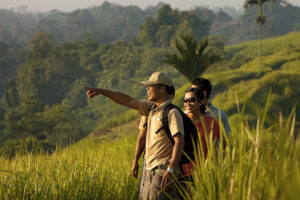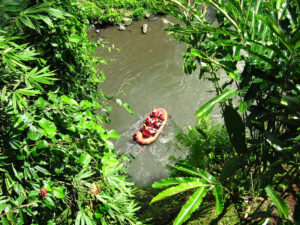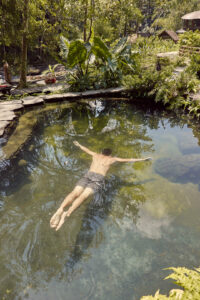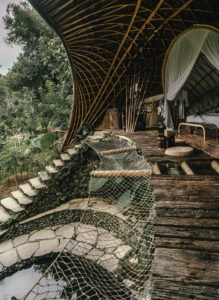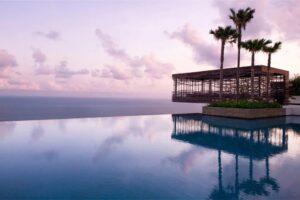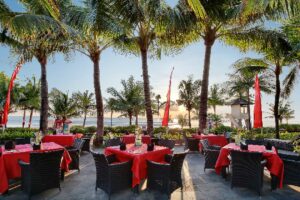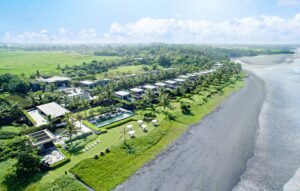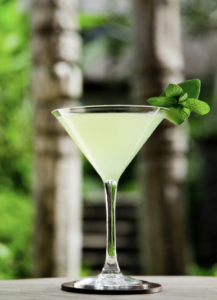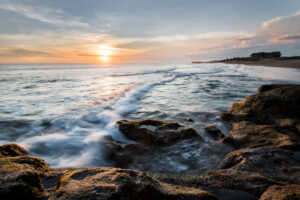Bali – Island of Gods and Spirits
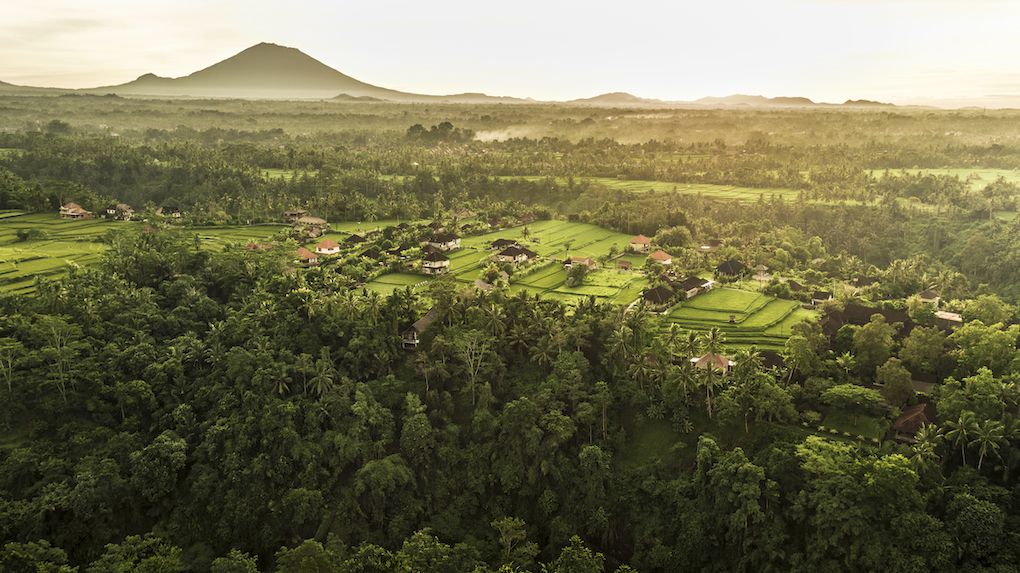
That’s Bali. White haze shrouds the mountains and valleys like a veil. The air is velvety, the temperature 25 degrees Celsius. Welcome to Bali, the island of gods, spirits, and mystical temples.
Worship of Bali’s gods and spirits are not to be overlooked on the grounds of the wellness hideaway Como Shambhala Estate. A mighty stone temple stands in the entrance area, protected by a black and white parasol. Every full and new moon, a religious Hindu ritual is celebrated on this hill, prayers are said in honor of the ancestors or Nyepi, the day of silence, is observed.
“Black and white represent good and evil,” Mika explains. He too is a follower of the Hindu religion, which over 90 per cent of Balinese follow. “Almost everything in Bali is faith,” he adds. “Two dragons hold the island, the spirits live on the beaches, the gods live on the mountains.
Unspoilt landscape
Mika is one of 60 butlers at the Estate. They make sure you get to yoga class on time. They organize canoe trips over the rapids of the Ayung or a tour by bike through rice fields. 30 residences and detached villas are available for overnight stays. They are spread over almost six hectares of natural landscape, which is tended by over 300 gardeners all year round. The architecture is Balinese, with lots of bamboo and tropical wood. Or contemporary with clean lines and panoramic windows. And each accommodation has its own pool, some also have a Jacuzzi fed by the waters of the nearby Ayung River.
Service is a priority at Como Shambhala Estate. Not only does every guest have his or her own personal butler, the resort also employs its own dietician. Eve Persak is responsible for the most important feature of the Como Group’s hotels and resorts: wellness holidays with customized meals for every need – from detox to diet and high-protein diets for extreme athletes to juice cures for people with gluten intolerance. “These personalized meals make the Como Shambhala Estate very different from conventional wellness resorts,” says Eve.
Good karma for all
We travel to the legendary artists’ village of Ubud, nestled on the volcanic slopes in the heart of Bali. The former royal town is famous for the film adaptation of the bestseller by Elizabeth George “Eat, Pray, Love” starring Julia Roberts. Many come to get good karma from one of the many healers, to have their picture taken with the monkeys in the Monkey Jungle, to browse for art in one of the many galleries. Mopeds, the main means of transport of the Balinese, buzz like exotic insects across the JL. Raya, the narrow main street of the small town of 30,000 inhabitants. They are heavily loaded with chicken cages and bamboo poles, now and then a live pig balances on the handlebars.
Offerings lie on the steps of the shops and cafés. Aviaries with colourful parrots stand on walls decorated with gold, their open gates allowing a glimpse into the traditional backyards. On the roadside just outside the village, Buddha figures made of polished wood, furniture and statues are displayed for sale. In the background, jade-green rice fields. Children, women and men are flying colourful paper kites. A ritual? This is the favourite pastime of the Balinese.
Jungle fever
Not far from the centre of Ubud is the boutique hotel Bambu Indah, another place where nature meets the gods. Coconut palms, cinnamon and tamarind trees fold over ferns, pineapple, and cassava plants, while a permaculture garden meets an enchanted, colourful jungle that drops steeply into the Ayung River valley.
The owners, John, and Cynthia Hardy, have used natural materials, including bamboo, to create ten beautiful and individual homes that touch all the senses.From luxurious tree houses with beds in air-conditioned gondolas, to cabins with four-poster beds and mini palaces high above the riverbank, to the Moon House made from woods of the jungle. Nature doesn’t get any better than this.
High up
Further south, the tropical vegetation gives way to a barren landscape. The Alila Villas Uluwatu Resort is located on the Bukit Peninsula, the southernmost tip of Bali. Passing through the entrance area, the view opens up over an infinity pool to the edge of a cliff 600 meters above the rocky coast of the Indian Ocean. A rectangular pavilion is enthroned at the very top. The airy, filigree construction made of wood bleached by wind and weather is reminiscent of a giant aviary floating dizzyingly far above the cliff. The edges of the shallow channels along the arcades leading to the restaurants are planted with lemongrass.
“This keeps the mosquitoes at bay,” explains resort manager Sean Brennan. “We do not use pesticides. We feel committed to Bali’s nature.“ Building in harmony with nature and according to the strict EarthCheck specifications was the primary concern of the architectural firm WOHA from Singapore. EarthCheck is the largest organization in the world that sets and rigorously monitors strict criteria for sustainability in the tourism and travel industry. “The building materials are locally sourced, the wood in the pavilions is recycled,” says Sean Brennan.
The villas are 84, with terraced roofs of Balinese volcanic stone that blend into the landscape. Each of the cottages has its own saltwater pool, the ceilings of the minimalist rooms are made of local bamboo, the wooden floors are made of recycled railway sleepers. The water from the washing machines and bathrooms is recycled and used to water the gardens. Alila Villas Uluwatu is proof that sustainable building and management works at 5-star level.
Pulsating life
The 5-starLegian Hotel near the popular Seminyak Beach is part of the Leading Hotels of the World. Balinese hospitality is celebrated here. There are 67 suites (studio suites, deluxe suites, two-bedroom suites and specialty suites), a three-bedroom Beach House and 14 private villas with private pools across the street from The Club at The Legian Bali.
The understated Balinese décor continues throughout; the cuisine is star level. In short: tropical elegance, class, and style. While the surrounding area is peppered with trendy boutiques and social venues, the hotel is a cocoon, with a beautiful infinity pool, an atmospheric spa and sunsets that are simply out of this world. Plus, gardens with wide lawns, bubbling fountains, banana trees stretching down to the beach. Ngurah Rai International Airport is only 15 km away.
Local colour
Soori, another luxury resort with EarthCheck certification, is in the west of Bali. Far away from the Kuta-Seminyak Gold Coast, where the building boom of recent years has left a concrete desert. Soori is situated on a kilometer-long black beach. Behind the two-story villas, you can see the peaks of the 2276-metre Mount Batukaru in the distance. Soori also places great value on local resources.
The terracotta tiles of the bathrooms were fired in the neighboring village. 70 percent of the food used in the Balinese-inspired cuisine comes from the surrounding Tabanan region. The culinary masterpiece: the Indonesian rice platter for a romantic dinner on the beach, torches, candles, and exquisite wines included.
Magical end
The west of Bali is a cultural paradise. On the “Journey of the Dancers” you get an insight into the art of Balinese dances. On the tour “All about Rice” you learn how rice is grown, harvested, and processed. The journey to the gods (“Journey of the Gods”) is the freestyle. Visits to five temples (puras) are on the program. There are fragrant Frangipani trees. Hawkers sell incense sticks and souvenirs. Offerings pile up on the temple tables of the Penarukan, Ulan Suwi and Taman Ayun puras: Baskets of rice, towers of fruit and orchid flowers.
A priest sticks some rice on each visitor’s forehead, the symbol of wisdom. The temple tour would not be complete without a visit to the Tanah Lot complex, built in the 15th century by the priest Pedana Bahu Rawuh on a rock in the surf. Girls dance, men drum. Spicy smoke fills the air. The gods are in high spirits, the demons in a mild mood. Bali celebrates. It is a daily magical festival.

My curriculum vitae is as colorful as the world. I was editor at ELLE, tested cars and participated at off-road tours. I lived on a small island in Florida for twelve years and from there I travelled the Caribbean and almost all states of the USA for various magazines, conducted interviews with interesting people, reported on beautiful homes and exotic travel destinations. After my return to Germany I worked for InStyle magazine for 14 years in various positions. And it was there that I first came into contact with the topic of beauty. To this day I still enjoy immersing myself in the fine cosmos of creams, perfumes and lipsticks. (photo: Thomas Dilge)
